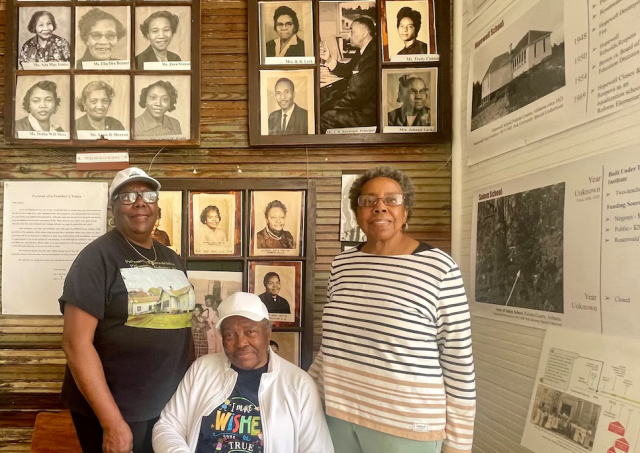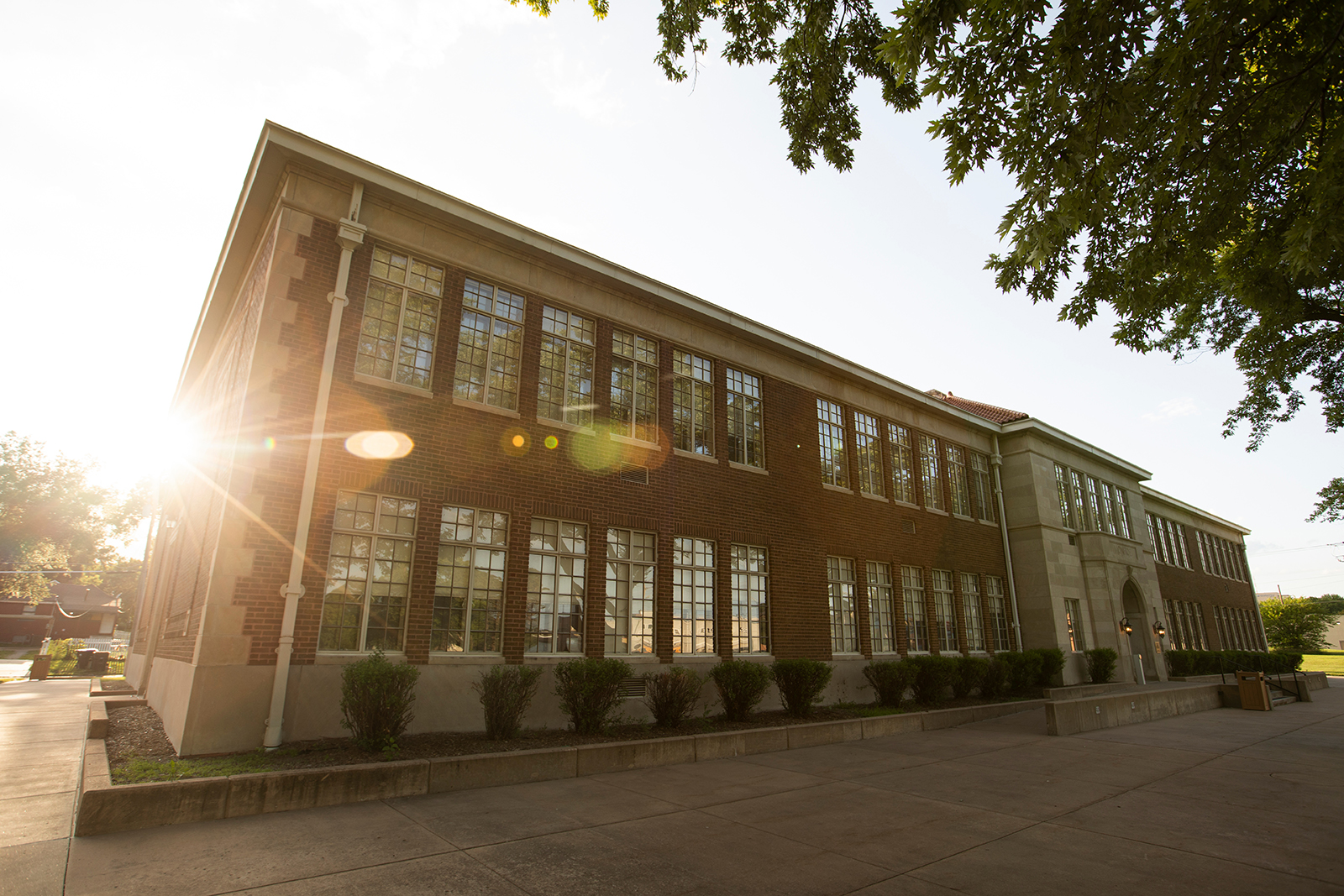
By Rebecca Griesbach | rgriesbach@al.com
EDITOR’S NOTE: On the 70th anniversary of the Brown v. Board decision, AL.com’s Education Lab examines the legacy of court-ordered desegregation — and what opportunity gaps still remain in communities today.
Paulette Locke-Newberns and her sisters, Mary and Carolene, remember the moment they set out to save their childhood schoolhouse.
Trees had begun to take root through the floor of the building in Pickensville, Alabama. Vines were starting to crawl across the indoor walls. Chickens from the farm next door had come inside to take roost. The foundation was so weak that it crumbled in their hands.
Then they turned their gaze toward a century-old wooden window sash, still intact in 2012 after all those years.
“It just starts with a vision,” Locke-Newberns said as she and her sisters showed off the historic school building this winter. “We were just looking at the windows here and said, what are we doing here? What can we do?”
Today, the Pickensville Rosenwald School, tucked between farmland just an hour west of Birmingham, is one of few remaining relics in the country of one of the largest and most impactful efforts to educate Black children in the first half of the 20th century. And while many buildings are gone, the legacy of quality Black education remains as living memory – and a community goal – for many.
It was in Alabama where Booker T. Washington had the vision for the federal program in 1913. With help from local communities, and funding from businessman Julius Rosenwald, he helped start nearly 400 Rosenwald schools across the state, which soon spread across the south.
At their peak, Rosenwald schools educated about one third of Black, school-aged children in the south, until many were forced to close during court-ordered desegregation.
For some alumni, the schools are a symbol of what was lost after the Brown vs. Board of Education decision 70 years ago: In many communities, Black students integrated white schools. When those students left their formerly all-Black public schools, many buildings were left behind, destroyed or repurposed. Lawmakers are just beginning to reassess whether local schools are funded equitably.
Today, historians have only been able to count about 15 Rosenwald schools that are still standing in Alabama. In Pickens County, which once housed six of the schools, just one remains in its original state.
“That’s a whole lot of school buildings that either we’ve lost or we don’t know where they are,” said Dorothy Walker, a historian at the Alabama Historical Commission who has been tracking and helping to preserve historic African American schools for much of her career.
But with more funding, and a devoted effort from Auburn and Tuskegee professors and state historical groups, local communities are hoping to reverse that trend – and shed light on their lasting significance.
“We all know the challenges that we’ve had in this state and in this country. But if we don’t preserve these spaces, we don’t have anything that we can look at and say, ‘That was a triumph for us to follow.’”
Kwesi Daniels, an associate professor of architecture at Tuskegee University who recently started a preservation program at the school.
A ‘Vital’ Effort
It wasn’t until later in life that Paulette Stinson Lavender learned her great grandparents donated the three acres of land that surround the Pickensville Rosenwald School today.
With the help of the community, her family raised about $7,000 to build the school in 1925. Her aunt also was a principal at the school, and her great aunt taught classes occasionally.
“They just valued education,” Stinson Lavender said. “They were farmers, and they just wanted better for their children and for future generations.”
Locke-Newberns, now 78, started first grade at the school in 1952 and attended through the eighth grade.
As she walked through the historic schoolhouse in February, she stopped at a stage along the far wall, remembering the piano lessons she took from the music teacher, Bernard Jackson.
The school educated dozens of Black children in Pickens County until a federal court order forced its closure in 1969. Each of the school’s three classroom spaces housed multiple grades of students, but those for the older grades were noticeably smaller. Many students, especially the boys, had to juggle school and duties on the farm as they got older.
“If you’re living on the white man’s property, he’s the boss,” Locke-Newberns said. “He says when you can and can’t go to school.”
After the school closed, the local board of education gave the property back to the community, only requiring that it be used for educational purposes.
But despite efforts to keep the building maintained, the school fell into disrepair. By the time the Locke family had gathered the funds to restore the building in 2012, contractors estimated it would cost about half a million dollars to reconstruct it.
So far, the group has cobbled together about $300,000 in donations and grants – enough to get the building in shape and open it to some community groups.
Now, those windows that inspired a vision years ago line the walls of a museum inside the school’s eighth grade classroom, where they frame portraits of the county’s early Black teachers. In every corner, there’s a tribute to the people who built, taught and learned in the school.
A historic marker stands in the front yard, and a gold nameplate on a restored window honors Job, a formerly enslaved man who was said to have stopped in the school to spread the Gospel to children and teachers.
In a middle room, boxes of Girl Scout cookies lay on top of 1920s-style desks. The school now hosts a local troop and an exercise class for seniors.
Locke-Newberns hopes to one day build a walking track outside, and perhaps a playground for children. But it could use another coat of paint first, she said, and a driveway and plumbing. The group is still accepting donations for ongoing projects.
Stinson Lavender, who lives out of state, said she’s grateful for local alumni who are preserving the school’s history – and giving it a new life.
“It’s now becoming another vital part of that community, because she just wanted to keep it alive,” she said.

‘That Story Needed To Be Told’
Rosenwald schools are only part of the story of early Black education in Alabama.
According to the National Register of Historic Places, six out of about 30 historic African American educational sites in Alabama have been registered in the last four years. More than a dozen others have recently been added to the state register.
But between funding challenges, finding qualified contractors and lengthy applications, the restoration process can be difficult.
“In many cases, especially when it comes to African American history, some of that information is not even available,” said Theo Moore, a local historian who has been helping communities across the state get local sites registered. “It’s bits and pieces of our history that make the application ‘incomplete.’”
Alabama’s oldest recorded African American schoolhouse that is still standing dates back to an 1867 church built by Mansfield Tyler, a self-educated, newly freed minister who later became one of the state’s first Black lawmakers. Today, the school’s owner is still seeking funds to fully restore it.
Jo Bolling McCall attended the Lowndesboro School in 1947 at the age of five with her four siblings, but she didn’t stay long. Her father, Elmore Bolling, a young entrepreneur who built a network of trucking and farming businesses in Lowndes County, was lynched that year, forcing her family to relocate.
“It sort of was a blocked memory after that devastating incident,” she said.
Decades later, a former classmate decided to donate the school’s land to a nonprofit organization, the Elmore Bolling Initiative, that Bolling McCall created in her father’s memory. On April 20, after years of work, she unveiled a historic marker honoring the school’s history.
If she can raise about $450,000 more, she hopes to transform the school into a museum and a technology center for local families.
“It’s significant for our young people to be able to see how enthusiastic the former slaves were in trying to get an education,” she said.
Across the south, newly freed African Americans were among those who devoted countless hours and resources to building schools for African American children.
In Perry County in 1867, nine formerly enslaved men built Lincoln Normal School, which would eventually become Alabama State University. At one point, it was a top producer of Black Ph.D candidates in the nation.
“The Lincoln school was a beacon, a bright light for educating Blacks in the Black Belt,” said Thomas Miree, who heads the Lincolnite Club, a group that formed after its closure to restore the school. “That story needed to be told, and it needs to continue to be told.”
In 1970, after the local school system desegregated, the city government took charge of the property and demolished several of its buildings. Miree and others suspect the destruction was in retaliation for the role that Lincoln students played in the Civil Rights Movement.
After buying back the auditorium in 1978 and the rest of the land in 1993, the alumni group was able to get parts of the site restored. In 2020, the National Historic Registry recognized the entire campus, unlocking opportunities for national grants. Members are now working to transform the gymnasium into a community center.
“It was worth it,” said alumna Mary Lou Essex, who led the painstaking effort. “It will enhance the appreciation of the people whose heritage is connected with the site. I just really feel that it will increase their appreciation of what they have.”
Mobile County Training School, once a high school for Black students in Mobile’s Africatown, still operates as a middle school. Alumni believe one of its buildings may also be a Rosenwald school, and are working with experts to classify it.
In the meantime, they’re enlisting current students to pass down its legacy.
Students have always helped run the school, kept it clean, and were taught to be leaders in their community, said Anderson Flen, president of the school’s alumni organization. With Flen’s help, the school will soon launch a student ambassador program to showcase its history.
“We want them to be a part of the effort to document this history, because that’s the way we were taught,” he said. “We were taught to do things, we were taught to learn how to become a part of the system.”
‘How Can We Have A Legacy?’
Walker, at the Historical Commission, started tracking Rosenwald schools after learning – years after her graduation – that her own alma mater in Dallas County had the designation.
Now, she’s working to shed light on an even less-discussed topic: Equalization schools that were built in the years between the Brown decision and desegregation efforts in the state. The mid-century, brick and mortar schools were built to create the illusion of equality, she said, but Black students were still often given less than equal opportunities. There’s no clear count of equalization schools, but there were a lot of them.
“When you get to the equalization story, it’s a different story,” she said. “It’s not the coming together of people. It is a deliberate process to separate and segregate people. And that’s much more of a difficult story to tell. But it’s an important story.”
Just miles away from the Pickensville School, other Pickens County communities are working to remember that complicated legacy. Hopewell High School was once a Rosenwald school for all grades, but reopened as an equalization school, Reform Elementary, in 1970.
“To me, the loss of the Black schools, the older schools, the older teachers, you lost that push that we had,” said Willie Glass, a Hopewell graduate. He was one of several Black students who desegregated Pickens County High School in the early 1970s.
Alumni still remember the sense of community they felt at Hopewell, and how it, in many ways, shielded them from discrimination and segregation outside its walls. The city’s first Black mayor, a graduate of Hopewell, declared a national holiday in honor of the school in 2017.
But until a few years ago, there were no markers of the school’s existence in the existing elementary building. And the local school board and the local library housed little documentation of its history.
“How can we have a legacy when the records are gone?” said one former student, Linda Smith, who started first grade at Hopewell in 1954.
Her classmate, Amanda McKinstry, helped name the school’s gym after former principal Joseph Randolph in 2017. Now she’s working to build an online site in honor of the school, and hopes to one day get it officially recognized.
“That’s why we’re fighting so hard to keep it alive,” McKinstry said. “That’s why we want that marker out there. We want the kids coming behind us to know about it.”




